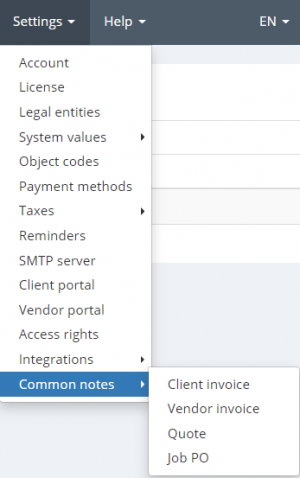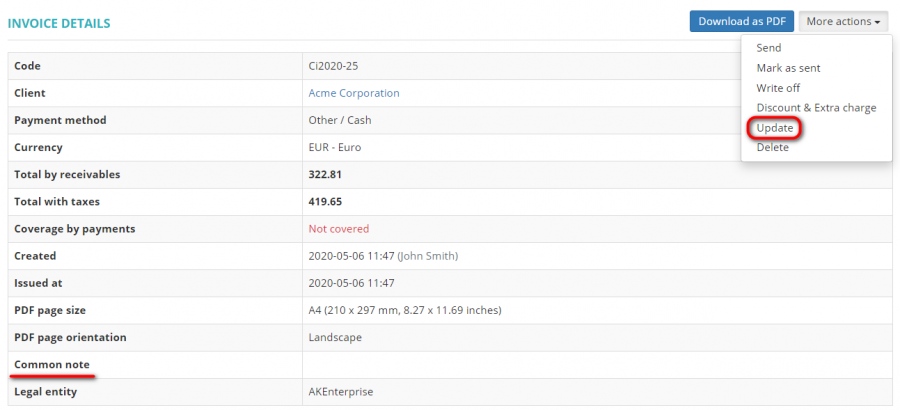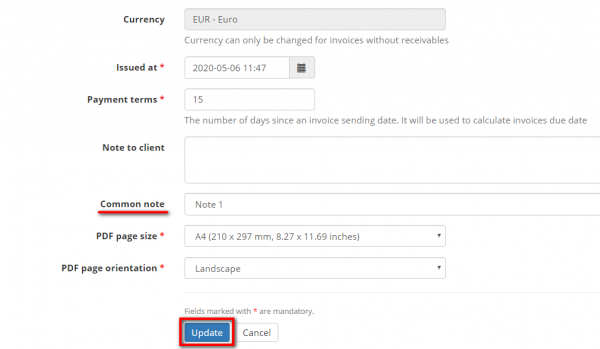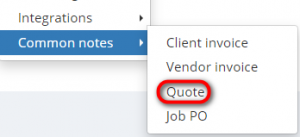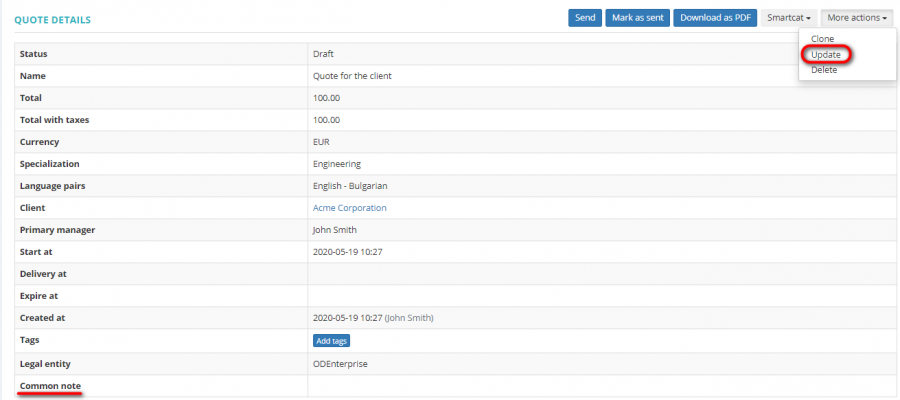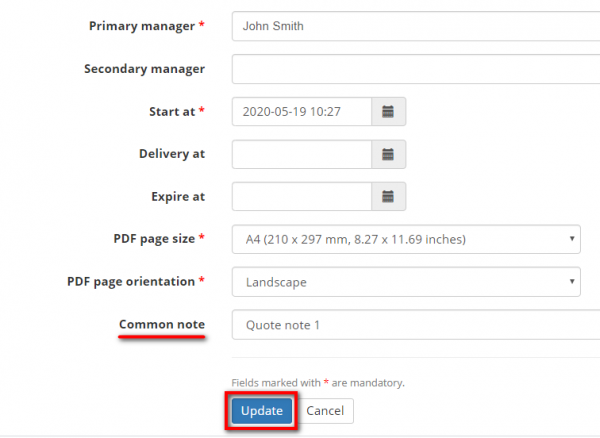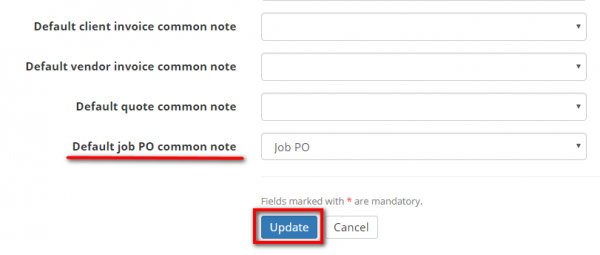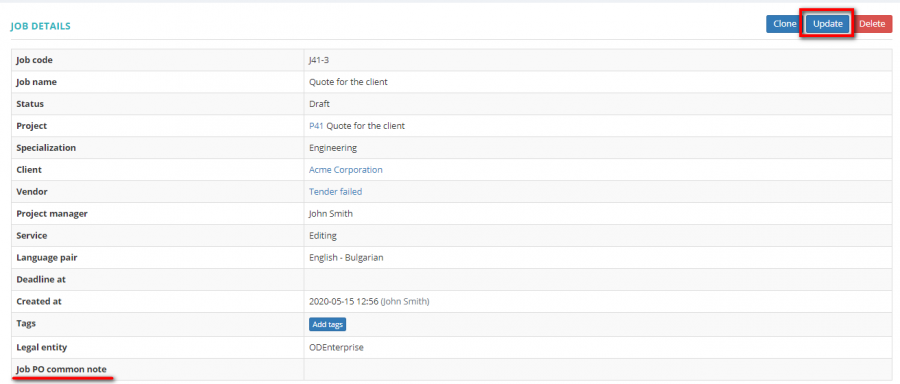PDF templates
Watch our video tutorial on Common notes - ![]()
You can define common notes for client invoices, vendor invoices, quotes and job PO.
Common note text can contain valid XHTML 1.0 markup. Allowed XHTML elements: a, b, br, div, h1, h2, h3, h4, h5, h6, hr, i, li, ol, p, span, ul. Allowed attributes: href, style.
To add the common notes, go to Settings → Common notes:
You always can update or delete the note:
Contents
Client invoice common notes
To add the client invoice common notes, go to Settings → Common notes → Client invoice:
Press "New common note":
Enter the name, the comment, and press "Create":
You can define a default client invoice common note and it will be displayed in every client invoice you issue.
Go to the Account page, scroll down to the Default settings, and press "Update":
From the drop-won list choose the needed one, and press "Update":
You can add a common note in an invoice.
Open the needed invoice and press "Update":
Choose the needed invoice common note from the drop-down list, and press "Update":
![]() Back to the table of contents.
Back to the table of contents.
Vendor invoice common notes
To add the vendor invoice common notes, go to Settings → Common notes → Vendor invoice:
Press "New common note":
Enter the name, the comment, and press "Create":
You can define a default vendor invoice common note that will be displayed in every vendors' invoices you issue.
Go to the Account page, scroll down to the Default settings, and press "Update":
From the drop-won list choose the needed one, and press "Update":
You can update the common vendor invoice note in invoices. Open the needed invoice and press "Update":
Choose the needed invoice common note from the drop-down list, and press "Update":
![]() Back to the table of contents.
Back to the table of contents.
Quote common notes
To add the quote common notes, go to Settings → Common notes → Quote:
Press "New common note":
Enter the name, the comment, and press "Create":
You can define a default quote common note that will be added to every quote you create.
Go to the Account page, scroll down to the Default settings, and press "Update":
From the drop-down list choose the needed one, and press "Update":
Add a common quote note for a client
You can update the common quote note in the needed quote when you create it.
You also can add the common not by pressing the "Update":
Choose the needed quote common note from the drop-down list, and press "Update":
![]() Back to the table of contents.
Back to the table of contents.
Job PO common notes
To add the job PO common notes, go to Settings → Common notes → Job PO:
Press "New common note":
Enter the name, the comment, and press "Create":
You can define a default job PO common note that will be added to every job you create.
Go to the Account page, scroll down to the Default settings, and press "Update":
From the drop-down list choose the needed one, and press "Update":
You can update the common job PO note for the needed job when you create it.
Or open already created job and press "Update":
Choose the needed job PO common note from the drop-down list, and press "Update":
![]() Back to the table of contents.
Back to the table of contents.
XHTML elements and attributes
| TAG | DESCRIPTION | EXAMPLE | VIEW |
| <a href> | The <a> tag defines a hyperlink, which is used to link from one page to another. The most important attribute of the <a> element is the href attribute, which indicates the link's destination. | <a href="protemos.com">Visit my website</a> | |
| <b> | The tag specifies bold text without any extra importance. | <b>This text is bold</b> | |
| <br/> | The tag inserts a single line break. | <br/> | |
| <div> | Defines a division part. It's a block-level element | <div style="text-align: center;">This text is in the center.</div> | 150px |
| <h1> to <h6> | Defines Headings level from 1 to 6 different sizes. | <h1 style="color:blue;">This is a heading</h1> | |
| <p style="font-size:12px">Text sample</p> | Defines the size of the text. | Text sample | 200px |
| <hr> | Represents a thematic break between paragraph-level tags. It is typically drawn horizontal line. | <hr/> | |
| <i> | The content inside is typically displayed in italic. | <i>This text is italic</i> | |
| <li> | The tag defines a list item. The <li> tag is used inside ordered lists(<ol>), unordered lists (<ul>) | <ol> <li>Quote</li> <li>Project</li> <li>Job</li> </ol> | 
|
| <ol> | The tag defines an ordered list. An ordered list can be numerical or alphabetical. The <li> tag is used to define each list item. | <ol> <li>Quote</li> <li>Project</li> <li>Job</li> </ol> | 
|
| <p> | The tag defines a paragraph. | <p>This project is due <span style="color: red;">30 days</span>.</p> | |
| <span> | The tag is an inline container used to mark up a part of a text, or a part of a document. The tag is much like the <div> element, but <div> is a block-level element and is an inline element. | <p>This is a <span style="color:blue;"> paragraph</span>.</p> | |
| <ul> | The tag defines an unordered (bulleted) list. Use the <ul> tag together with the <li> tag to create unordered lists. | <ul> <li>Quote</li> <li>Project</li> <li>Job</li> </ul> | 
|
| <style> | Used to add CSS style, e.g.: - Underline the text - Align the text. |
<p style="text-decoration: underline;"> Your text </p> <p style="text-align: center;">This text is in the center.</p> |
85px 150px |
For text to start from a new page - <p style="clear: both; display: block; page-break-after: always;"></p>
That's the example on how your invoice can look like:
Note: please avoid this sign & because the system doesn't allow to save the common note.
